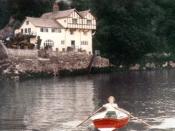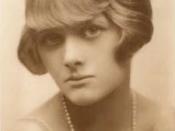Daphne Du Maurier's Frenchman's Creek is an eloquent love story which takes place on the coast of England, Cornwall to be precise, in the late eighteen hundreds. The main character Dona St. Columb is the wife of a well to do London man. Dona becomes bored of her socially hectic city life and moves herself, children, and the nanny to Navron, the families second home in Cornwall located on Frenchman's Creek. Upon arriving to the French manor, Donna meets the new members of the staff. The newest of which is William, the head servant, who just so happens to be the former employee of a pirate. Come to find out the pirate, also know as the Frenchmen, had been sleeping in the very bed in which Lady St. Columbs takes to her slumber.
One day while walking the grounds of Navron, Dona stumbles upon a ship named La Mouette at harbor in the creek.
Upon further investigation, she is accosted and taken back to her mansion. This act just intrigues her more; therefore she calls for the owner of the boat to join her for dinner one night. Come to find out the man who joins her for dinner is the Frenchmen or William's previous boss. The evening goes well, quite well in fact, that Dona is asked if she would like to go fishing. This dinner is the point in the book where romance first becomes evident.
As the two of them spend more time with each other, they develop a unique relationship. Because Dona is married and has children, and the fact that the captain of La Mouette leads a scandalous life, they keep their love under wrap. This is done not only to protect them, but St. Columbs as well. As the two become more acquainted with each other the plot thickens.
Both Lady St. Columb and the pirate make a bet, which is as follows, that if Dona could stay on the boat for the full length of an adventure that would consist of overtaking another boat, then the Frenchmen would have to steel her neighbor's, Goodolphin's wig. If she could not last the entire trip then she would have to give the pirate her ruby red earrings that he admired so much. Indeed they agreed to the terms and their trip would start immediately.
Voyaging across sea, paddling through rough turf, and escaping from the enemy at hand, all describe events that occurred during Dona, and the pirates first of several other outings together. The danger to Donna made the trip ever more exciting and even more desirable.
"Another flash, another deafening report, and this time there was a tearing sound of splintering wood, but Dona could see nothing, she only knew that someone had thrown a rope down into the boat, and someone was pulling them close to the side of the ship, and there were faces laughing down at her, and hands that lifted her, and away beneath her was the black swirl of water and the little boat upside down, disappearing in the darkness" (131, DD).
In the end, as the clock stuck twelve, Cinderella, (Dona) watched her prince, (the pirate), climb aboard his ship and leave never to return again. So sad is life, especially when a person such as Dona St. Columb lets fantasy take over reality. Daphne Du Maurier follows the out line of the classic motif that of which would be the Cinderella story.
Jane S. Bakerman writes, "All of her plots are thrilling and allow for abundant complication and offer good possibilities for quick pace and great suspense" (280, Bakerman). How true this is, The fact that a female city dweller of this time period would leave a predominately wealthy man to pursue another man who is less than the perfect citizen, a pirate in fact.
Other critics beg to differ, take for instance what Basil Davenport has to say about Daphne's writing styles and techniques; "Forty-eight hours after having turned the first page of Frenchman's Creek you have some difficulty in remembering what it was all about. What you do remember is the impression of rich, satiny, glass-slippered triumph that Miss Du Maurier made in reading, the conquering Prince Charming atmosphere of the entire performance. Remembering that, the details of an almost preposterously innocent but very smooth, very skillful, very bright-eyed fairy tale come back. This is the story, in a vague restoration setting, of a gallant French pirate and a beautiful lady of St. Jame's who loved and parted. By all the rules it should have turned out a tame if decorative trifle. Miss Du Maurier, of course, makes rather more of her little effort, but exactly how she achieves her effect of truly romantic sensibleness is something of a mystery. The tale has ease charm, a certain finish, and yet none of these things seems to matter very much by comparison of her tone of voice. It is this ring of innocent assurance in the matters of pure ordinary conviction with the extra-romantic make-believe that does the trick" (162. Davenport).
According to Berkerman, Du Maurier tends to emphasize on some very old methods of writing such as ancient folk literature. Daphne is able to convey to the reader a character who is a self conscious second wife, worried, the dangerous dark-haired beauty, the dark, mysterious male, the ineffectual male seeking self definition and power, and bend them to her will with great and immense skill.
"Yes," he said, "if we so wished. But Dona St. Columb is not Dona the cabin boy. She is someone who has a life in another world, and even at this moment she is waking in the bedroom at Navron, with her fever gone, remembering only very faintly the dream she had. And she rises, and dresses, and sees to her house hold and her children" (142 Du Maurier).
This quote, directly from the book, is a prime example of how Daphne displays her great and creative manipulative writing styles.
It is important that Cinderella's triumph include public humiliation, of which Dona St. Columb is privy to, when she is placed in jail and is looking for a place to stay after an adventure goes a rye. "Because the evils which Cinderella confronts, overt cruelty, jealousy and selfishness, are easy to identify and are subject to social disapproval, the wicked are punished: justice, seemingly is served." (281, Davenport) The element of crime is often found in the Cinderella story. In Frenchman's Creek, Dona must dress as a cabin boy in order to do mischievous things. One criminal act that Dona partakes in is the taking of Goodolphins boat, and goods aboard.
"No, you are right," she said, "there is no escape for a woman. Therefore if I sail with you again I shall be a cabin-boy, and borrow Pierre Blanc's breeches once and for always and there will be no complications of a primitive nature, so that our hearts and our minds can be easy, and you can seize ships and make your landings on the coast, and I, the humble cabin-boy, will brew your supper for you in the cabin, and ask no questions, and hold no conversation with you" (143 Du Maurier). A fantastic excerpt showing how well Du Maurier uses the Cinderella story motif to elude to the fact that just maybe Dona St. Columb and the Frenchman pirate are both scandalous and romantic at the same time.
All in all, Daphne Du Maurier's Frenchman's Creek is the epitome of the Cinderella story in a nineteenth century setting, written by a twenty first century author. How great Du Maurier is to be able to subliminally speak or parody the classic and never forgotten story of a lady who finds true love in the forbidden.
Work Cited Bryfonski, Dedria. Contemporary Literary Criticism. Detroit: Gale Research Company, 1979. Volume11.
O' Faolain, Sean. The Spectator. Spectator 1936.
Rogers, Pat. "Saving Her Bacon." The Spectator. 9 June. 1977: page 60 Matuz, Roger. Contemporary Literary Criticism. Detroit: Gale Research Company, 1990. Volume 59 Bakerman, Jane S. "Daphne du Maurier." And Then There Were Nine"æ More Women of Mystery. Bowling State University Popular Press, 1985.
Davenport, Basil. "Sinister House." Saturday Review. 24 September. 1938: page 5.
Du Maurier, Daphne. Frenchman's Creek. Arrow Books, 1992




